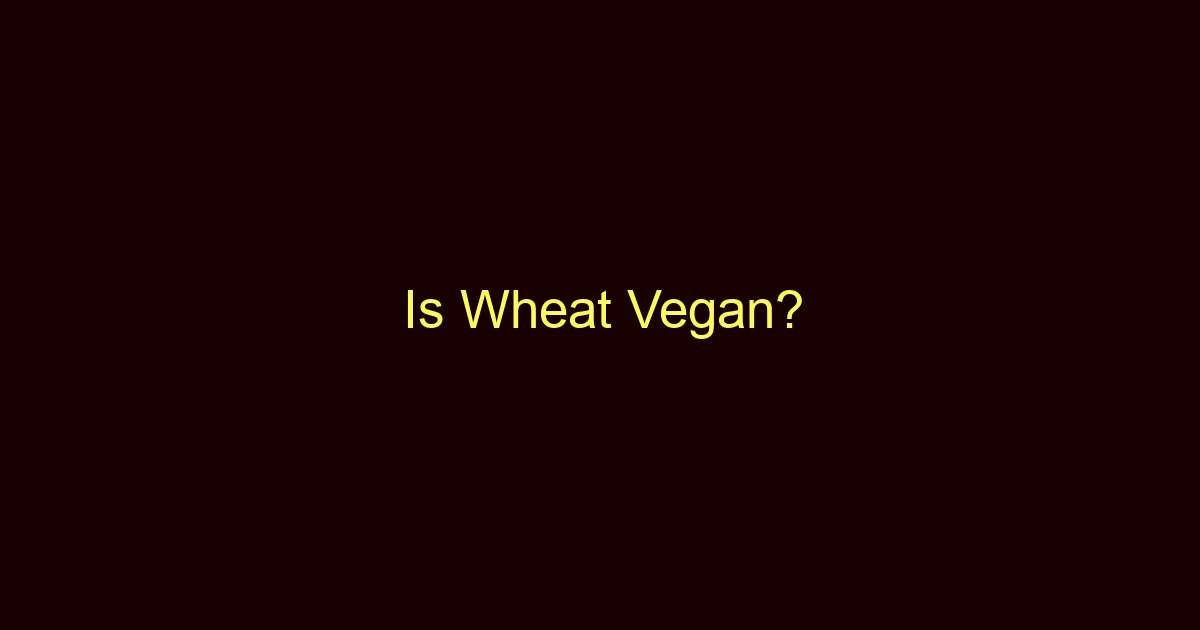Welcome to this in-depth look at one of the world’s most widely consumed grains: wheat. In this article, we’re going to examine whether wheat can be part of a vegan diet and delve into what it is, what it’s used for, and its potential health implications.
What is Wheat?
Wheat is one of the oldest and most widely grown crops on earth. Originating in the fertile crescent about 10,000 years ago, this grain has become a staple food source for civilizations across the globe due to its versatility and rich nutritional profile.
Wheat is a member of the grass family, and it’s typically grown in temperate climates. The plant’s life cycle starts with sowing seeds in the autumn, growing through the winter, and harvesting in the spring or summer. Each wheat plant produces a head filled with hard, small kernels, the wheat berries that we consume in various forms.
What makes wheat truly remarkable is the array of food products derived from it. Wheat’s omnipresence in our diet is truly astounding from bread, pasta, and pastries to beer and a variety of processed foods. Its prevalence is due in large part to the gluten it contains, which gives dough its elasticity and baked goods their structure.
What is Wheat Made Of?
Wheat is an intriguing composite of nutrients, with its primary constituents being carbohydrates, proteins, and a small fraction of fats. One of the main proteins found in wheat is gluten, which makes wheat a prime ingredient in the making of bread and other baked goods due to its elasticity.
The grain is also a rich source of dietary fiber and comes packed with vitamins and minerals like B vitamins, iron, calcium, and magnesium. Whole grain wheat, in particular, is recognized for its nutritional completeness as it includes all parts of the grain the bran, germ, and endosperm.
What is Wheat Used For?
Wheat has an incredibly wide range of uses, primarily in our diets. We consume it in many forms, including whole grains, flour, and various processed foods. Bread is perhaps the most common product made from wheat, followed by pasta, breakfast cereals, pastries, and cookies.
Apart from food, wheat also finds use in other sectors. The straw leftover after harvesting the grain is used for bedding livestock, while wheat gluten can be processed into a variety of non-food items like biodegradable cutlery, food packaging, and even film for cameras.
Is Wheat Vegan?
Yes, wheat is indeed vegan. This means that it doesn’t involve the use of animal products or byproducts in its cultivation, harvesting, or processing. However, it’s always essential to read the labels of processed foods that contain wheat as they may also include non-vegan ingredients.
The Health Benefits of Wheat
Whole wheat, especially, has been associated with a range of health benefits. Its high fiber content aids digestion, helps to control blood sugar, and can contribute to feelings of satiety, which may support weight management. Additionally, the nutrients found in wheat, like magnesium and B vitamins, play a role in a variety of bodily functions, including the immune response, energy production, and DNA synthesis.
Moreover, research suggests that whole grain consumption may lower the risk of heart disease, type 2 diabetes, and certain types of cancer. However, it’s worth noting that these potential health benefits are often linked to eating whole grains as part of a balanced diet, not in isolation.
The Environmental Impact of Wheat
Like any other form of agriculture, wheat production has environmental impacts. These include the use of water, potential soil degradation, and the release of greenhouse gases. However, compared to animal agriculture, wheat cultivation generally has a lower environmental footprint.
On the flip side, there are also opportunities to make wheat production more sustainable. Organic farming methods, crop rotation, and the use of cover crops are just a few strategies that can help to protect soil health, conserve water, and reduce the need for synthetic fertilizers and pesticides.
Is Wheat Safe?
For most people, wheat is a safe and nutritious food to include in their diets. However, some individuals cannot tolerate wheat or gluten, as in conditions like celiac disease, wheat allergy, or non-celiac gluten sensitivity. For these individuals, consuming wheat can lead to a variety of symptoms and potential health complications.
Even for those who can consume wheat with no issues, it’s important to aim for variety in the diet. Just as eating too much of any one food isn’t ideal, relying too heavily on wheat at the expense of other whole grains like oats, barley, and quinoa could limit the diversity of nutrients in your diet.
Final Thoughts
Wheat is an integral part of many diets around the world and is unequivocally vegan. Its nutritional benefits and versatility make it valuable, provided it is consumed as part of a varied and balanced diet. Wheat is a suitable food for vegans that can contribute positively to their nutrient intake.
However, it’s crucial to remember that not all wheat-containing foods are vegan, and not all individuals can tolerate wheat. Always check food labels for hidden non-vegan ingredients or allergens, and consider seeking professional advice if you suspect wheat or gluten intolerance.
Overall, wheat’s journey from the fertile crescent to our dining tables has been one of adapting to our changing needs, and it’s certain to remain a staple food for many people worldwide.

